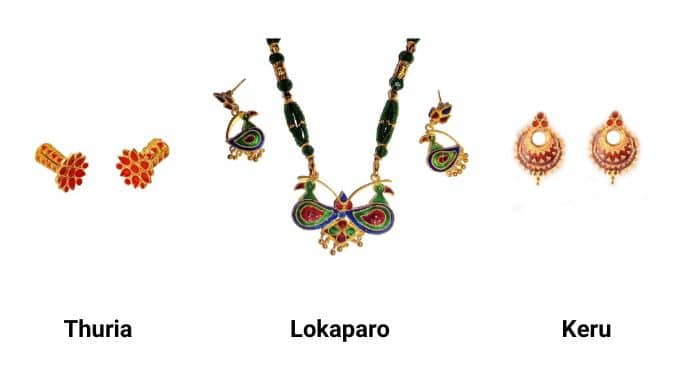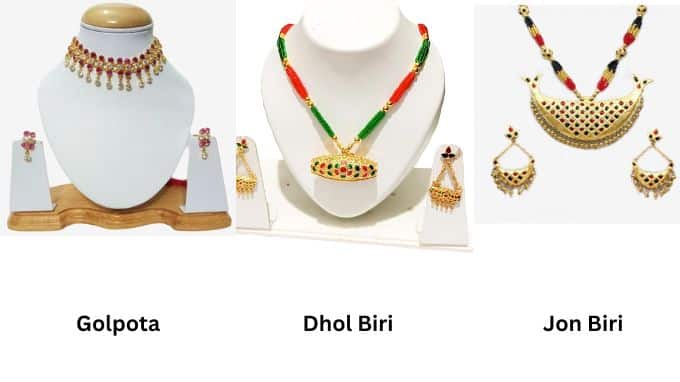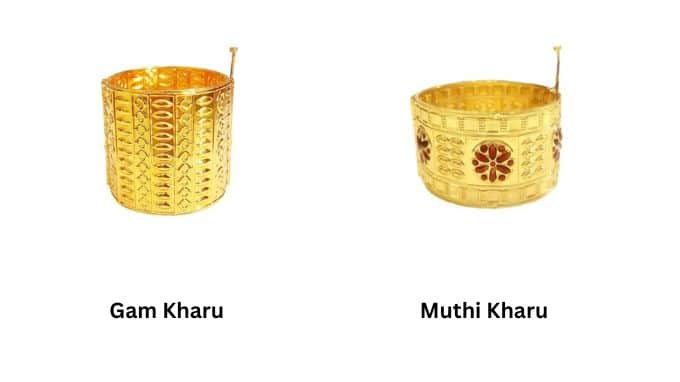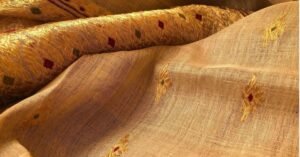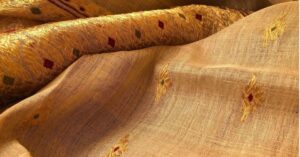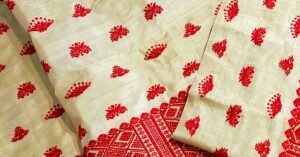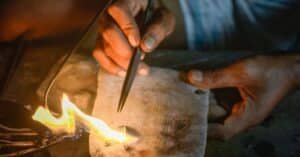Assam has a rich history and tradition of making handcrafted jewellery. Assamese jewellery or Asomiya Gohona is predominantly crafted by hand, with its designs often featuring representations of the region’s rich flora and fauna of North East India. The traditional Assamese jewellery designs are characterized by their simplicity, adorned with vibrant red gemstones like rubies or mina. Among buyers, the combination of black, red, and green colors on gold jewelry is highly favored, mirroring the color palette that also prevails in the traditional attire of the various tribes and communities of the northeastern states of India.
History of Assamese Jewellery
The history of Assamese jewellery is steeped in tradition and timeless allure, dating back to ancient times. Early historical references, including Madhav Kandali’s translation of the Ramayana and Sankardeva’s Rukmini-Haran Kavya, illuminate the rich world of Assamese ornamentation, describing the ‘Batrisa alankara(32 ornaments)’ and providing intricate insights into various jewelry pieces with cultural significance.
Edward Gait’s historical account in ‘A History of Assam’ highlights the importance of gold washing and jewelry manufacturing during the Ahom period. Gold extraction from the sands of the Brahmaputra River was a significant industry, with individuals engaged in gold washing required to pay a yearly tax to the royal exchequer. Gold was abundant along various rivers and streams, contributing to the state’s substantial income. The title ‘Sonowal’ was given by the Ahom kings to the persons who were experts in the field of gold washing. The river ‘Sowansiri’ too, got its name for carrying abundant quantity of gold in its sands. The terms ‘Xon Komowa’ or ‘Xon Khopa’ were used to refer to the techniques for extracting gold from the sands of rivers flowing down from the mountains. This historical narrative underscores the enduring legacy of Assamese jewelry, where craftsmanship, cultural symbolism, and the pursuit of beauty have remained intrinsic to Assam’s cultural heritage.
The community which resorted to gold washing as their main source of livelihood were thus, known as the ‘Sonowals’ and the people who were engaged for washing silver were known as the ‘Rupowals’ or ‘Thengals’.
How It Was Made during Ahom period?
The lands of Assam have long been blessed with the abundant presence of gold, known as ‘Son’ or ‘Xon’ in Assamese, scattered within the sands of various Himalayan Rivers coursing through the region. Therefore, for generations, Assamese artisans have practiced the art of alloying gold with other metals, a technique known as ‘Bhaj diya.’ In ancient Assam, the metal of choice for alloying with gold was often silver, resulting in a harmonious blend of durability and elegance in their jewelry creations. The great Ahom king Rudra Singha welcomed artisans from outside the state into his domain, and over time, these artisans integrated into Assamese society, playing a pivotal role in the gradual transformation of traditional Assamese jewellery.
Traditional Jewellery Centers of Assam
The craft of making traditional Assamese jewellery continues to thrive in three notable pockets: Ranthali in Nagaon district, Sonari Gaon in Jorhat district, and Barpeta Town in Barpeta District.
In Sonari Gaon, Jorhat, the frame of the jewellery is made entirely of gold. Other than gold, lac, leaf gold (Pat Xon) and stones are used in the production of jewellery of Sonari Gaon. In Ranthali, lac, gold leaf (Pat Xon) and stones are also used, but the frame of the jewellery is made of silver instead of gold. In Barpeta Town, the jewellery is made mostly in silver and occasionally in gold; but lac, leaf gold (Pat Xon), and stones are not used in the production of jewellery in Barpeta Town.
The artisans, who are called Sunaris or Karikars are highly skilled craftsmen who inherit their skills of manufacturing jewellery from their forefathers.
The Process of Making Assamese Jewellery
When crafting with gold, the artisans primarily use 99% pure gold (24 carats), referred to as “Kecha Sonar Gahana” or “Pat Sonar Gahana.” Raw gold (kesa xoon) has a softness that makes it inapt for crafting intricate jewellery. Therefore, for generations, Assamese artisans have practised the art of alloying gold with other metals. Earlier, the metal of choice for alloying with gold was silver, resulting in a harmonious blend of durability and elegance.
The process begins with machine-smoothing the gold, which is then cut into the required sizes and packed in white paper. After this, the artisans employ tools such as a “haturi” and other small instruments to shape the gold pieces into smooth, fine plates suitable for creating ornaments.
For silver jewellery, three essential elements— “Tar,” “Vissile,” and “Pat”—are used, and at least two of these must be incorporated into the jewelry’s design. To join these silver elements and form specific designs, a strong adhesive called “Pine” is used. “Pine” is made by mixing silver, tin, and bronze.
To enhance the aesthetic appeal, artisans utilize “Mina,” a special color, as well as various colorful stones. The stones and “Mina” are meticulously applied using tools known as “Nuoni” and “Kanchani,” with pure gold often used to encase them. In addition, small, colorful bead-like elements called “Moni” are employed in Assamese jewellery, and they are often strung together to create necklaces using a small plastic thread.
Types of Assamese Jewellery
Traditionally, Assamese culture has been adorned with a rich tapestry of diverse ornaments, reflecting the deep-rooted heritage and artistic flair of its people. Over time, as modernity has woven its influence into the cultural fabric, three particular types of jewelry have risen to prominence in Assamese fashion: earrings, necklaces, bangles and rings.
Earring
During the Ahom dynasty, earrings were a popular form of adornment worn by both males and females, reflecting the cultural and fashion preferences of that era. However, as time passed and fashion evolved, the practice of wearing earrings gradually became more common among Assamese females, particularly when they donned the traditional Assamese dress. Asomiya Gohona include earrings such as exquisite Lokaparo, Keru, Thuriya, Jangphai, , Sona or Makori.
Lokaparo: As ‘Lokaparo’ means pair of pigeons, various motifs inspired by pigeon are crafted in Lokaparo. Lokaparo is usually made of gold and bakhor(pearl or mineral). Nowadays, it is designed as both as earring and necklace.
Keru: These are also known as Zangfai Keru. They are gold plated and bakhor(pearl or mineral) plated. Keru is an ear ornament, which is famous and popular in Barpeta
Thuriya: Thuria means ‘starshaped’. Thuria is much like Keru, but smaller and elongated in shape. They are also called Long Keru.
Necklace
Necklaces are an exquisite and integral feature of Assamese jewelry, playing a significant role in enhancing the beauty of Assamese women. They are often worn in combination with the Assamese Mekhela Sador, which is the typical attire for Assamese women. This combination creates a stunning ensemble, representing the perfect blend of tradition, elegance, and timeless style. Common necklaces of which makes up Assamese Jewellery are Golpata, Joon biri, Bena, Gejera, Dhol biri, Doog-doogi/ Dugdugi, Biri Moni, Mukuta Moni, Poalmoni, Silikha Moni and Magardana,
Golpota: Assamese women wore g0lpata or golpota around their necks. There are two beads or chains on either side of the stalk. The locket of the golpata/golpota is has structure like Kero, but its size is larger. Sometimes, numerous lockets of even size were attached to the string.
Jon biri: Jon Biri is the most widely used Assamese jewellery and it is known to all. It has a a crescent-shaped design just like crescent moon as the literal meaning of the word ‘Jon/Joon’ which means Moon in Assamese. It is worn as a pendant.
Dhol biri: Dhol biri is another commonly used Assamese jewellery. It has a a dhol-shaped design.
Doog-doogi: Doogdoogi is a heart shaped neck ornament. Doog-doogi / Dugdugi is just like golpata, but larger in size and has intricate designs like mina and often studded with pearls. A gold ornament worn from the neck to the chest. It looks like a pan Its pendant is made of gold-plated pomegranate beads.
Gezera: It is a neck ornament of Assamese women with a slightly flattened raised part in the middle of the necklace and a moon-like turn on both heads and a scalp on the body.
Rings
Assamese rings are more than just adornments; they serve as cultural symbols, often featuring intricate designs that reflect the region’s heritage and traditions. These are often worn by bride/groom or gifted to married couple during Assamese marriage. Some common rings are Senpata, Horinsakua, Jethinejia, bakharpata and others.
Bangles
Bracelets are locally known as Kharu. There are essential during any ritual or traditional dances. Intricate designs of these bracelets are mesmerizing. These are primarily worn by Assamese women. Some commonly used bracelets are: Muthi Kharu, Gamkharu, Dhanchira etc. Gam kharu was traditionally was worn by men on their wrist. Gamkharu is a broad bracelet made in silver or gold with a clasp. In earlier times, even men used to wear Gamkharus, but have since become very popular with women.The design can be worn with both traditional and contemporary attire. While Muthi Kharu is an important ornaments for women, especially during traditional dance.
Changes in design and style of Assamese Jewellery
The artisans crafting traditional Assamese jewelry have embraced innovation to cater to the evolving demands and preferences of their customers. These creative adaptations include introducing new motifs like the ‘Kapou ful,’ a local orchid, which adds a touch of regional identity and natural beauty to the pieces. Additionally, there has been a shift towards producing jewelry as sets, combining items like necklaces and earrings, as opposed to single standalone pieces, exemplified by creations like the ‘Dugdugi set.’ Moreover, the artisans have modified the design of ‘Lokapara,’ a type of earring, from round to flat, offering a unique twist on a classic design. Another noteworthy innovation involves crafting ‘Thuria’ in two separate pieces instead of one, making it easier to wear and enhancing the convenience and versatility of these cherished Assamese ornaments.
However, the finishing of Assamese jewellery is also not at par with the international standards. So, despite having beautiful designs, items of Assamese jewellery often comes with improper finishing like, sharp edges, imperfect enamelling, loose earring studs, etc. Traditional artisans of Assam making Assamese jewellery needs support from industry and government.
Recently, there have a significant rise in businesses in Assam which deals in Assamese jewellery. Brands like Doogdoogi, Zangfai have been able to maintain quality standards and meet the expectations of customers searching for Assamese jewellery.


